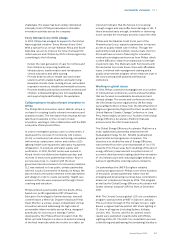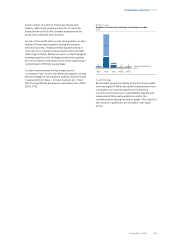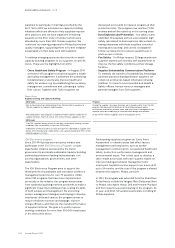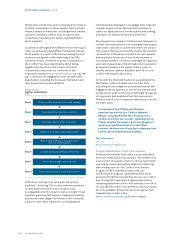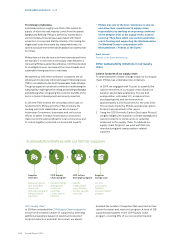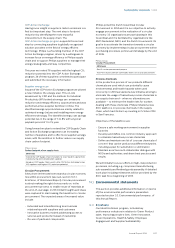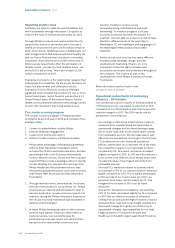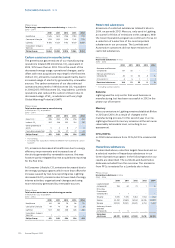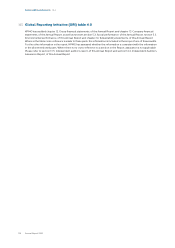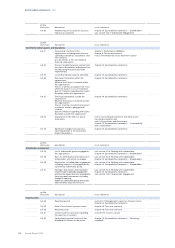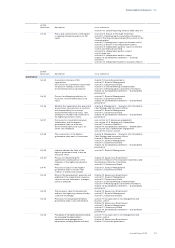Philips 2014 Annual Report Download - page 207
Download and view the complete annual report
Please find page 207 of the 2014 Philips annual report below. You can navigate through the pages in the report by either clicking on the pages listed below, or by using the keyword search tool below to find specific information within the annual report.
Sustainability statements 14.2.8
Annual Report 2014 207
CDP Action Exchange
Having more insight in supplier’s carbon emissions is a
rst but important step. The next step is footprint
reduction by identifying the most impactful
interventions in the supply chain. The
CDP Action Exchange program supports this second
step by connecting suppliers to globally recognized
solution providers in the eld of energy ecient
technology. Philips is a founding member of the CDP
Action Exchange program, driven by a willingness to
increase focus on energy eciency in Philips supply
chain and to support Philips suppliers to manage their
energy strategically and stay competitive.
This year we invited 76 suppliers with the highest CO2
reduction potential into the CDP Action Exchange
program. 24 of these suppliers committed to participate
and submitted the necessary information.
Supplier energy scan
As part of the CDP Action Exchange program we piloted
a new initiative: the energy scan. This on-site
assessment by CDP and the Institute for Industrial
Productivity (IIP) looked at energy use, emissions
reduction and energy eciency opportunities and was
performed at two supplier facilities in China. The
identied savings opportunities are mainly related to
optimized energy (re)use and installing more energy
ecient technology. The identied energy cost savings
potential lies in the range of 3 to 8% with a typical
payback period of 1 to 1½ year.
Going forward we plan to extend the CDP Supply Chain
and Action Exchange programs to an increasing
number of suppliers and to oer more suppliers energy
scans, with the ambition to further reduce our supply
chain carbon footprint.
Philips Group
Carbon footprint of our supply chain
2015 Goals
Extend the CDP Supply Chain invitations to cover top 80% spend from
manufacturing and transportation suppliers
Based on CDP Supply Chain results, oer CDP Action Exchange to top
100 suppliers with highest CO2 reduction potential
Circular Procurement
A key driver in the transition towards a circular economy
lies within procurement (see sub-section 14.3.1,
EcoVision, of this Annual Report). Circular procurement
is about making the right choices early on, in the
procurement process, to enable reuse of materials at
the end-of-use stage. In 2014 initial thoughts and ideas
were captured to start making the transition to circular
procurement. The expected areas of increased value
include:
• Extended and intensied long term business
relationships with suppliers and customers
• Innovative business models addressing access to
services and products instead of ownership
• Re-use of parts and components
Philips joined the Dutch GreenDeal Circular
Procurement in 2014 and it is our objective to actively
engage procurement in the realization of a circular
economy. 33 organizations are participating in this
GreenDeal and it is facilitated by organizations like
MVO Nederland, NEVI, and the Dutch Government. Its
goal is to accelerate the transition towards a circular
economy by implementing circular procurement within
purchasing processes, policies and strategy by the end
of 2016.
Philips Group
Circular Procurement
2015 Goals
Start 2 circular procurement projects
Train 40% of procurement commodity teams on circular procurement
Process chemicals
In the production process of our products dierent
chemicals are used which can potentially cause
environmental and health hazards when used
incorrectly. In 2014 we started a new initiative striving to
eliminate the usage of hazardous process chemicals in
our supply chain and – when no alternatives are
available – to minimize the health risks for workers
dealing with these chemicals. Philips initiated a new
EICC taskforce on process chemicals in the supply
chain, which had its start-up meeting in October 2014
in San Francisco.
Objectives of the taskforce are:
• Ensure a safe working environment in supplier
factories
• Develop and dene one common industry approach
to eliminate hazardous process chemicals
•Dene and maintain one list of “process chemicals of
concern” that can be used across dierent industries,
including a plan for substitution or elimination
• Maintain an active multi-stakeholder dialogue with
NGOs and authorities, and share best practices and
results
We will initially focus our eorts on high-risk production
processes, including e.g. component manufacturing,
sub-assembly and nished goods assembly. A detailed
work plan including milestones will be provided by the
EICC task force beginning of 2015.
14.3 Environmental statements
This section provides additional information on (some
of) the environmental performance parameters
reported section 5.3, Environmental performance, of
this Annual Report.
14.3.1 EcoVision
Our latest EcoVision program, includes key
performance indicators in relation to Green Product
sales, Improving people’s lives, Green Innovation,
Green Operations, Health & Safety, Employee
Engagement and Supplier Sustainability.


